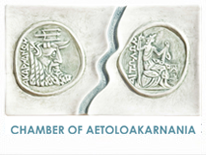It is a national religious holiday which is established and associated with two specific historical events that took place during the revolution of 1821:
The first historical event concerns the civil strife that broke out in 1824 in the Peloponnese, between politicians and the military, and put the revolution in great danger. At that time, Mavrokordatos, who was in Aetoliko, in order to prevent the spread of this phenomenon in Roumeli, summoned the chiefs of Northwestern Greece, to discuss the situation and make decisions.
The meeting place was set at Ypsili Panagia, which was an inaccessible, ruined Byzantine monastery on the west side of Zygos. This place was chosen for absolute secrecy and security. The date of this meeting is supposed to be the 23rd of August, which coincided with the Assumption of Virgin Mary, which was celebrated in the monastery in a large religious ceremony.
The assembly was held in the presence of the priest, with the object of making decisions regarding the end of the civil war between the military and politicians and the issues of survival and development of the struggle that plagued both the warriors and the inhabitants of the region. At this assembly the chiefs formed a complete picture of the situation and decided to reconcile in order to face the enemy together. Immediately after the end of the meeting, the priest came out first and with one of his gestures showed to the gathered crowd that everything is fine and the chiefs followed reconciled and with joy. Then the people started cheering and the Roma, who were there with the people, started playing “ntaouli” and “pipiza”. Everyone started dancing and having fun. Then the chiefs took the road back to Aetoliko, with people following them with dance and songs.
Immediately after the liberation of the nation, and especially after the liberation of Aetoliko on May 14, 1829, in remembrance of this event and feeling debt to Virgin Mary, the people of Aetolia decided to honor Her Grace and went to Ypsili Panagia in an annual established ceremony, taking the color of the national religious holiday. Due to the fact that the specific location was inaccessible, dangerous and steep and the monastery was ruined, they built the church of Saint Agathi a little lower and in a more easily accessible place. The celebration was established there, when the name of Saint Agathi was given, instead of the pre-existing Ypsili Panagia.
The second historical event concerns the fall of Dolma. The islet was attacked by Ibrahim, with 2,000 Egyptian spearmen, on 28th of February, 1826. After the fall of Dolma, Ibrahim turned against Aetoliko. Several people from Aetoliko tried to escape in the early hours of 1st March, 1826 with “passares” (small boats that took the cargo from the larger ones into the sea and transported them to the port), passing by the north side of the lagoon to Vounaki Almyros and from there to Ypsili Panagia. For their rescue, Ibrahim negotiated in order to keep the most beautiful woman of Aetoliko Tasoula Kourkoumeli, as his personal booty.
In remembrance of the above events, the festival of Saint Agathi was established in 1835 in memory of the fallen fighters.
Internet sources
READ MORE
- The Feast of Saint Agathi in Aetoliko - Historical data
- The places associated with the realization of the festival
Source: |
 |
INTANGIBLE CULTURAL HERITAGE of UNESCO |










